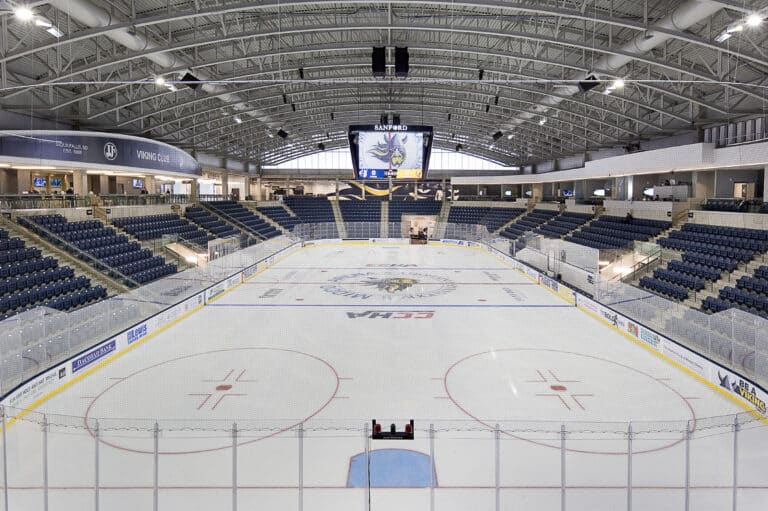UConn anticipates opening its new ice hockey rink at Storrs in fall 2021, financing it through a development partnership in which the University stands to gain significant revenue annually from ice time rentals to community groups, youth hockey leagues, and other organizations.
UConn officials received the go-ahead this week to negotiate with three developers who responded to the University’s Request for Expressions of Interest (RFEI) late last year. Proposed agreements with the preferred developer will be negotiated over the next few months and submitted to the Board of Trustees for its approval.
“We’re sending a message to the world that we’re serious about this,” Scott Jordan, UConn’s executive vice president for administration and chief financial officer, told members of the board’s Financial Affairs Committee and the Building, Grounds, & Environment Committee at a joint meeting this week.
Those committees approved the financing approach, reporting their actions back to the full Board of Trustees at its meeting Wednesday.
UConn joined the Hockey East Association for men’s ice hockey starting in the 2014-15 season. As a condition of being admitted, the University promised to meet the conference’s requirement of an on-campus arena with 4,000 seats. Hockey East has since approved UConn’s request to reduce the number of seats in the arena to 2,500.
Depending on the design, UConn plans a hockey arena with 2,500 to 3,500 seats that will be built adjacent to the current Freitas Ice Forum, which will continue to be used for practices and other activities.
The new $45 million arena will host all games of the women’s ice hockey team – which has been in Hockey East since the 2002-03 season – and some games of the men’s team, which plays primarily at the XL Center in Hartford.
It will also be available to be rented by recreation groups, hockey leagues, and other organizations. UConn expects to garner at least $400,000 annually in revenue from those rentals.
The new rink is anticipated to have about 75,000 usable square feet, and at least 2,500 seats. Whatever number of seats is initially provided, there must be expansion capacity to reach 3,500 in the future.
The arena facilities and ice will also meet all NCAA Division I ice hockey requirements and all Hockey East regulations, which the Freitas Ice Forum does not. With that in mind, Hockey East gave UConn some leeway when it allowed the University to join the conference for men’s hockey despite needing time to provide an appropriate facility.
“Having talked with the commissioner of Hockey East, I know how important it is for us to keep our word to them,” said Board of Trustees member Thomas Ritter, who is also chairman of the board’s Buildings, Environment, and Grounds Committee.
David Benedict, UConn’s director of athletics, said that while most of the men’s ice hockey games will continue to be played at the XL Center in Hartford, having on-campus games could also help build the student fan base – which could translate to more students deciding to ride the buses to Hartford games, as they do for some basketball games.
Benedict agreed with Ritter that making this week’s substantive progress on the plan will be a good signal to Hockey East that UConn is serious about its promise.
“They will be ecstatic if we get a shovel in the ground soon,” he said.
The financing plan envisions the creation of a Special Purpose Entity (SPE) as the legally binding vehicle for the development partnership. The developer will create the SPE, and will be responsible for building the facility and staying on schedule. Once it’s open, the University will operate it on a day-to-day basis.
To pay for the new rink:
- The SPE will issue tax-exempt bonds worth $22.5 million for the project. UConn will pay $1.6 million yearly on the debt, though that will be partly offset by the $400,000-plus that UConn gets as its share of gross revenue from the rink rentals.
- UConn will use $12.5 million temporarily from its reserves as a cash advance, with the amount to be paid back through philanthropy and athletics revenue. That is not an unusual method, Jordan said, noting that many colleges and universities do the same thing as they plan major capital projects.
Benedict said one donor has already expressed interest in giving $6 million for the project, and that they expect others will also be excited about supporting the rink. “There’s obviously more prospects out there, and we’ll look forward to going out to talk to them as soon as we know we’re moving forward,” he said.
- The other $10 million will come from revenue that UConn is receiving through the sale of the former West Hartford campus and the Nathan Hale Inn. Under state statutes, income that the University receives from selling properties must go back into capital projects – which would include the ice rink – and cannot be used for operating expenses.
Jordan said the University is also committed to maintaining the parking capacity in the Athletics District area, and will require that parking for about 750 vehicles must be available adjacent to the new arena.
The university’s “I Lot,” a parking area near Freitas, currently has spots for about 350 commuter students. Depending on the design of the new rink and its surroundings, Jordan said, the number in that lot could go up to 400.
“We know there’s a parking crunch on campus, and this is an opportunity to add some capacity,” he said.
The tentative project schedule anticipates that university officials will negotiate with the three competing developers in coming weeks, and reach tentative agreements to be presented this winter to the Board of Trustees.
If all remains as scheduled, construction would start in early 2020 and take about 18 months, with the arena opening in fall 2021.





